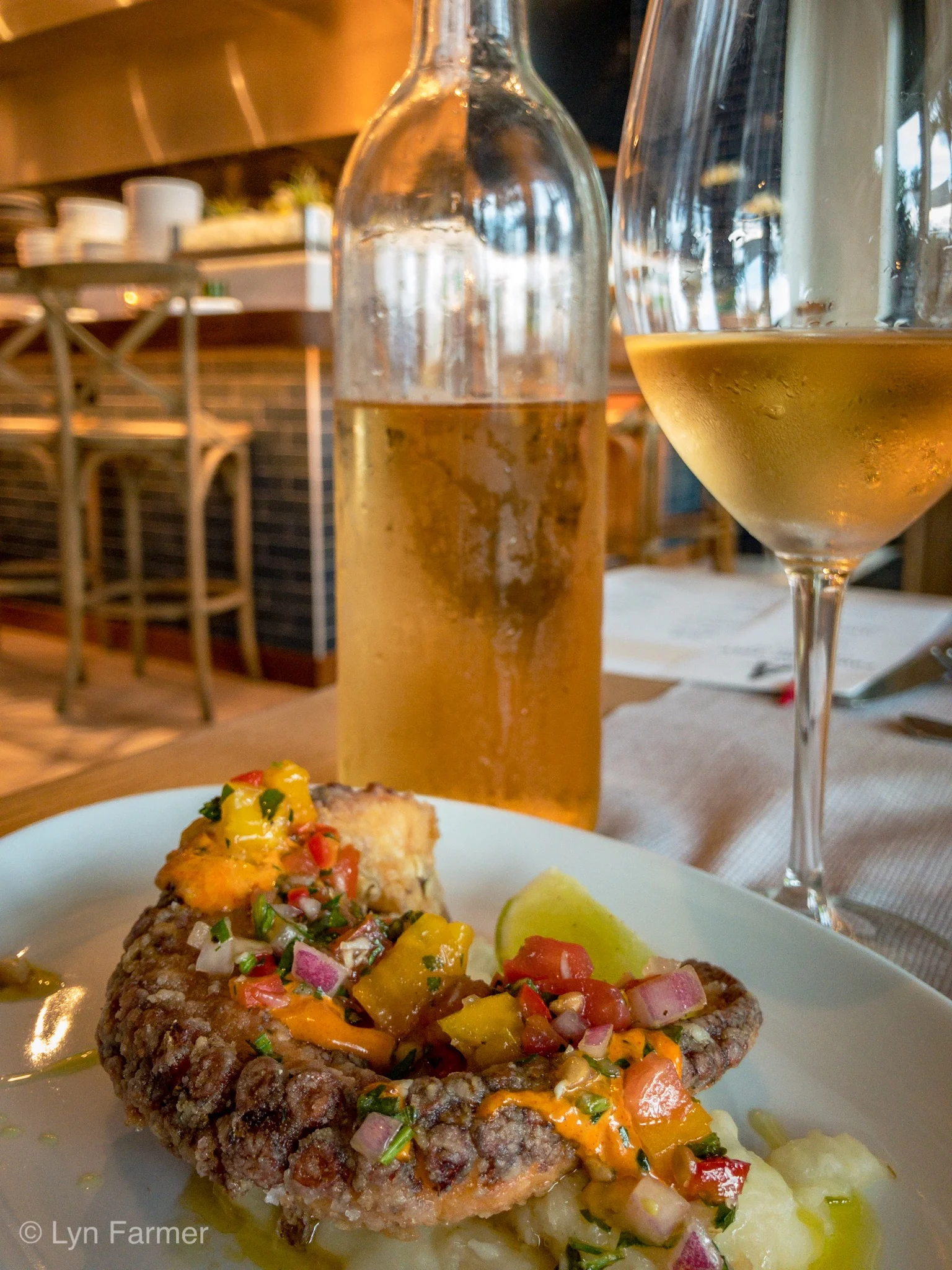Tapping into Trendy Rosé
/On a recent visit to Paso Robles in Central California, I spent a wonderfully inspirational day with Jason Haas of Tablas Creek Winery. I'll write more in depth about the experience and why I found it so motivating, but with the dog days of summer here in the Northern Hemisphere, I have to take a moment to sound a cheer for rosé wine, a cheer set off by one of the rosés Jason makes at Tablas Creek.
Patelin de Tablas Creek Rosé with seared octopus at Amara at Pariaso
Patelin de Tablas Creek Rosé
There are two rosés at Tablas Creek - one made from estate fruit from the winery's extensive vineyards, and a second rosé made from grapes purchased from the winery's longest-term growers. This is called Patelin de Tablas Creek - patelin is a French slang word roughly meaning "in the neighborhood," a further tribute to nearby growers who have had a relationship with the winery since it was founded in the late 1980s. There are Patelin de Tablas Creek white wine and red wine as well, but it is the grenache-dominated rosé that particularly won my heart at the winery, and then dazzled me at a restaurant near my home in Miami, Amara at Paraiso.
Owned by James Beard Award-winning chef Michael Schwartz and with a wine list curated by my good friend Amanda Fraga, Amara has a menu that harkens to influences from Latin America and the Caribbean with a few Asian touches as well. And there on the wine list, I found Patelin de Tablas Creek Rosé...on tap!
Rosé on Tap!
A hundred and more years ago it was typical for merchants to purchase wine in cask and bottle it themselves, but that led to too many cases of fraud and the trend since the late 1800s has been for a winery to bottle its own wine - you've probably seen the inscription "Mis en boutille au Château" (Bottled at the winery) on the cork and/or label of many French wines.
Amanda managed to buy a barrel of Patelin and it makes perfect sense for a restaurant that wants to feature a rosé by the glass - you plug in the wine as if it were a keg of beer and draw it out of a tap into a glass or a carafe (at Amara they use a clear wine bottle as a carafe). Because the wine is forced out by nitrogen gas under pressure no oxygen comes into contact with the wine until it is pushed through the tap, so it remains pristinely fresh from winery to your glass, whether you've ordered the first glass of the keg or the last.
The Patelin de Tablas Rosé is a beautifully crafted wine - from its pink and tangerine color to the vibrant strawberry and raspberry fruit and clean acidity that is a refreshing hallmark of the best dry rosés. The palate is what intrigues me most about this wine - it is surprisingly complex for a wine style many as simple. In common with the best Bandol rosés from the South of France, this one has layers of red and orange fruit flavors and a laser beam of minerality at its core.
Rosé is one of my go-to wines not just in summer but throughout the year, and nothing beats a grenache-focused rosé in my book, whether it's from the south of France or Paso Robles. I do love those meaty rosés based on mourvèdre from Bandol (Domaine Tempier is a long-term favorite), and I would never turn down a luscious syrah-based rosé from Côtes de Provence, but I confess to a passion for grenache, and so Patelin is a particular favorite.
A glass of cabernet sauvignon rosé with Mulderbosch winemaker Adam Mason
Cabernet Rosé from Mulderbosch
Then again, great rosé can be made from many grapes. I just had dinner (also at Amara, coincidentally) with winemaker Adam Mason from South Africa's Mulderbosch winery, and he noted that the best-selling wine from his property is a rosé made from cabernet sauvignon (and I can see why - it's delicious). Adam leaves the grape skins with the juice for a minimal time: "It gets plenty of color just by pressing it slowly," he says, and the result is a vibrant deep pink color that is very appealing. The wine in the glass is equally appealing - crisp acidity and a clean juicy flavor of black fruit. This isn't the cassis-laden fruit of a cabernet sauvignon at full ripeness - that wouldn't provide enough acidity for a zesty rosé. Instead, they pick the cabernet for the rosé at a slightly lower point of ripeness to preserve the acid freshness. That acidity guarantees it goes well with many types of food. Adam's flagship wines are made from chenin blanc, the most important grape in South Africa to my mind, but this cab rosé was a real eye (and palate) opener for me as I discovered how well it paired with roast chicken, grilled grouper, citric ceviche and the seared octopus I liked so much with the Patelin rosé. Rosé might just be the (nearly) everything wine!
Do you have a favorite rosé? And, do you love it enough you enjoy it year-round? Let me know what you like - let's compare notes, and cheers!



